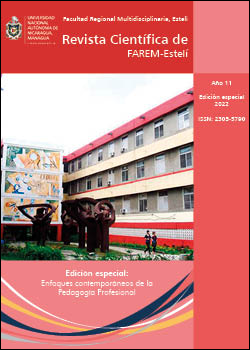Evaluation of the incidence of cycles on the level of service of non-signalized intersections in the city of Holguín
DOI:
https://doi.org/10.5377/farem.v11i3.14914Keywords:
Cycles, capacity, level of service, non-signalized intersectionsAbstract
The analysis of traffic circulation in the urban area is complex, since there are several parameters involved in vehicular currents. In the Highway Capacity Manual (Highway Capacity Manual, 2010), different analysis methodologies are established to evaluate the traffic operation conditions; but they must be adapted to the characteristics of the area where the study is carried out. Such is the case of using it in the Holguín territory, where the volume of cycles is high and they are not considered. In order to use the methodology for non-signalized intersections, it should be adjusted with a factor that considers the cycles, because if this is not done, the results will not be in accordance with what is perceived in the field. The main objective of this research is to evaluate how cycles affect traffic operation at non-signalized intersections in the city of Holguín through the analysis of capacity, Level of Service and the determination of a factor of equivalence of cycles to light cars to achieve the same calculation unit. The study uses a group of theoretical, empirical and statistical methods that allowed to verify from the traffic studies that the equivalence factor of cycles to light cars of 1: 0.33 (1 cycle equals 0.33 car) and in the analysis without the consideration of bicycles of the operating condition of the current flow is favorable (Level of Service C); however when taking it into account, an unfavorable condition is reached (Level of Service E) which shows the negative incidence of these means of transport in this type of location.
Downloads
References
Asamblea Nacional de Poder Popular (2011). Ley 109. Código de Seguridad Vial. Editorial Capitán San Luis, Capítulo II. La Habana, Cuba.
Cal, R., Reyes, M., y Cardenas J. (2007). Ingeniería de tránsito. Fundamentos y aplicaciones. Capítulo 12- Pág 354-433. Alfaomega Grupo Editor, S.A. de C.V.
Depiante, V., Galarraga, J. (2010). Intervalos críticos y capacidad en intersecciones no semaforizadas de tres ramas. Universidad Nacional de Córdoba. Argentina.
Depiante, V. (2011) Giros a la izquierda en intersecciones no semaforizadas. (Tesis de Maestría en Ciencias de la Ingeniería. Mención Transporte). Universidad Nacional de Córdoba. Argentina.
Gallegos, R. (2005). Efecto de la regularidad del pavimento en la Capacidad Vial de las Carretera Multicarriles. Disertación doctoral no publicada, Universidad de las Villas, Villa Clara, Cuba.
Gibson, J. (2001). Teoría de flujos vehiculares. Apuntes. Universidad de Chile. División Ingeniería y Transporte. Chile.
Luttinen, T. (2003). Capacity at Unsignalized Intersections. TL Consulting Engineers, Ltd. Lahti. TL Research Report No 3. ISBN 952-5415-02-3, ISSN 1458-3313.
Olano, E. y Soler, E. (2019). Propuesta de ordenamiento de la circulación de los ciclos en las vías de centro de ciudad de Holguin, Cuba
SEDESOL. Manual de estudios de ingeniería de tránsito. Tomo XII. Programa de asistencia técnica en transporte urbano para las ciudades medias mexicanas. Ciudad de México.
Soler, E., Portal, M. (2017). Evaluación de la incidencia de los ciclos sobre el nivel de servicio de intersecciones no semaforizadas en la ciudad de Holguín. Tesis en opción al título de Ingeniero Civil. Universidad de Holguín, Cuba.
Soler, E. (2018). Efecto de las brechas en el funcionamiento de intersecciones controladas por señal de Pare. Tesis en opción al título académico de Máster en Ingeniería Civil, mención Obras Viales. Universidad de Camagüey “Ignacio Agramonte y Loynaz”. Cuba
TRB (2000). - Highway Capacity Manual (HCM) - Chapter 17-Unsignalized Intersections Special Report 209 - TRB, National Research Council, Washington, D.C.
TRB (2010). Highway Capacity Manual (HCM) - Chapter 17-Unsignalized Intersections Special Report 209 - TRB, National Research Council, Washington, D.C. 21.
Published
Issue
Section
License
Copyright (c) 2022 Revista Científica de FAREM-Esteli

This work is licensed under a Creative Commons Attribution-NonCommercial-ShareAlike 4.0 International License.



